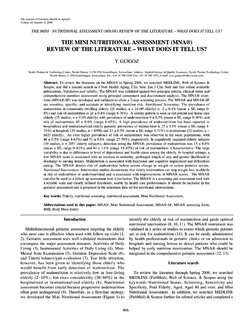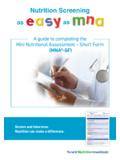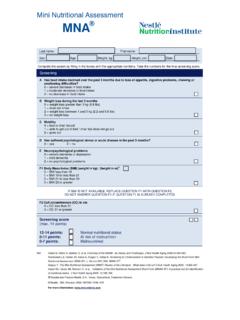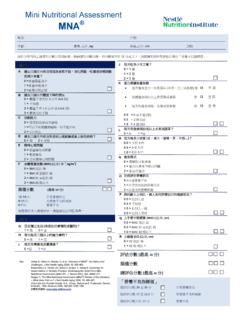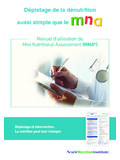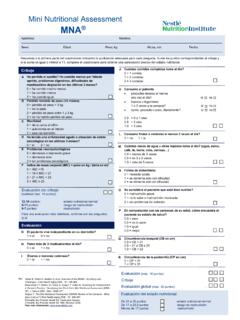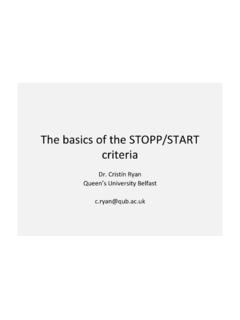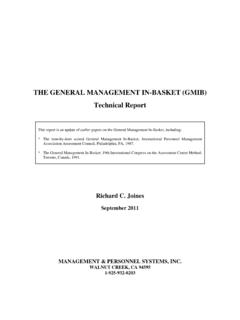Transcription of A SELF-COMPLETED NUTRITION SCREENING TOOL …
1 IntroductionIn 2000, there were approximately 35 million Americansaged 65 years or older and million aged 80 years or 2030, these numbers are projected to increase to anestimated 71 million and million persons, respectively (1).Decreases in food intake by an older adult can have far worseconsequences as they are more likely to suffer from multiplemedical conditions, causing severe physiologic and bodycomposition changes (1). The demographic epidemiologic shifttowards an increasing proportion of the aging populationcoupled with continuous changes in dietary and nutritionalpatterns have presented the field of public health with newchallenges. In an era of healthcare reform and self-directedcare, patients have become more involved in their own healthmanagement. Previous studies have found that malnutrition and being atrisk for malnutrition exists in 38% of community older adultsworldwide (2), and malnutrition may be present in up to 50% ofelderly adults (3).
2 Malnutrition, which is frequentlyundetected, is the cumulative effect of the often compromiseddietary habits of the elderly and the physiological changesassociated with aging. It is associated with a significant risk ofmorbidity and mortality in independently living older adults, aswell as in nursing home residents and hospitalized patients (3). The purpose of nutritional SCREENING is to quickly identifyindividuals that are malnourished or at risk of malnutrition (4).National and international societies recommend routinenutrition SCREENING to identify malnutrition and the risk ofmalnutrition (4, 5). The characteristics of an effectivenutritional SCREENING tool include: simplicity, utilization ofreadily available data or data that is easy to obtain, and theinclusion of data relevant to nutritional status. Ideally, aneffective SCREENING tool will result in a viable intervention andwill also be international societies recommend the use ofnutrition SCREENING tools to facilitate the identification ofmalnutrition (4, 5).
3 One of the most common barriers towidespread and regular NUTRITION SCREENING of the elderly hasbeen the lack of a validated, convenient SCREENING tool that iseasily and quickly administered by healthcare professionals(HCPs). For this reason, the Mini Nutritional Assessment(MNA), developed by Guigoz, is a SCREENING tool that can beused to identify geriatric patients ( 65 years) at risk ofmalnutrition (6, 7). The Mini Nutritional Assessment ShortForm (SF-MNA ), is a 6-question short form of the MNA thatcan be completed in 5 minutes or less. The MNA has beenvalidated in international studies with a broad range of HCPs ina variety of settings (6, 8). Currently, this instrument isadministered by HCPs to determine patients nutritional status. We hypothesize that greater gains could be made in the earlydetection of declining nutritional status if the elderly couldassist in the identification of their own nutritional status bycompleting the self-administered MNA (Self-MNA)themselves, or if it could be completed by a family member orother caregiver.
4 For this reason, we conducted a study toA SELF-COMPLETED NUTRITION SCREENING TOOL FOR COMMUNITY-DWELLING OLDER ADULTS WITH HIGH RELIABILITY: A COMPARISON STUDY HUHMANN1, V. PEREZ2, ALEXANDER3, THOMAS41. Nestl Health Science, Parsippany, NJ; 2. Exponent, Inc. Health Sciences, Chicago, IL; 3. Exponent, Inc. Health Sciences, Boulder, CO; 4. Division of Geriatrics/Gerontology, University School of Medicine, St. Louis, MO. Corresponding author: Maureen B. Huhmann, Nestl Health Science, Parsippany, NJ, USAA bstract:Objectives: Malnutrition is common in community-dwelling older adults and is associated with pooroutcomes including hospitalization and mortality. Recently, a 6-question short form mini nutritional assessment(SF-MNA) was validated for rapid NUTRITION SCREENING . Ideally, NUTRITION SCREENING could be performed byindividuals or their caregivers prior to or during an outpatient clinical visit, thus allowing for the ongoingmonitoring of nutritional status among older adults.
5 Design:We compared the SF-MNA administered by ahealthcare professional (HCP) to a 6-item self-administered SCREENING tool (Self-MNA) in 463 communitydwelling older adults who gave informed consent. The population was 60% women with a mean age of The HCP was blinded to the results of the Self-MNA questionnaire. Results:Using the SF-MNA, 27% ofsubjects were malnourished, 38% were at risk, and 35% had normal NUTRITION status. The agreement between theSelf-MNA and the SF-MNA was 99% (Self-MNA sensitivity 99%, specificity 98%, false negative rate 1%, falsepositive rate 2%) for identifying Malnourished subjects and 83% (sensitivity 89%, specificity 77%, false negativerate 11%, false positive rate 23%) for identifying At Risk of Malnutrition compared to the MNA-SF administeredby a HCP. Conclusion:We found that the Self-MNA demonstrates sufficient inter - rater reliability for use innutrition SCREENING among community-dwelling older adults.
6 Further validation studies and the possible impactof language translation should be words:Malnutrition, NUTRITION SCREENING , elderly, older Journal of NUTRITION , Health & Aging Volume 17, Number 4, 2013 Received December 5, 2012 Accepted for publication January 7, 201314 HUHMANN_04 LORD_c 05/03/14 09:39 Page339determine the inter - rater agreement between the Self-MNA andSF-MNA by comparing the level of agreement in thecategorization of nutritional status between both SCREENING toolsin a population aged 65 years or older when completed byeither the individuals themselves or by their caregiver. MethodsThe Self-MNA was created by modifying the patient interviews, each item of the SF-MNA wastested with individuals aged 65 years or older. Table 1illustrates the changes in the Self-MNA as compared to the individuals aged 65 years or older and caregiverswere recruited to attend an in-person interview in one of 40centrally located market research facilities.
7 Subjects andcaregivers were recruited using multiple sample sources,including Kantar Health s Lightspeed Consumer Panel, facilitydatabases, and newspaper advertising. HCPs were recruitedfrom Kantar Health s panel of HCPs. For consumers to be included in our study, they must havebeen at least 65 years of age and able to speak, read, and writein the English language. For the inclusion of caregivers, theymust have been a family member, relative, friend, orprofessional caregiver of an individual aged 65 years or olderwho also lived with or visited that individual five or more daysa week. Additionally, the caregiver must have been able tomake decisions or must have had a strong influence on theelderly person s diet and medical needs. HCPs in our studymust have been in practice for two to 30 years as a primary carephysician or nurse. He/she must have also spent at least 70% oftime with direct patient care and must have treated at least 100patients per month with at least 60% of the population treatedbeing aged 65 years or older.
8 The HCP was also required to bethe individual responsible for handling all patient/caregiverquestions related to study protocol underwent Institutional Review Board(Copernicus Group IRB) approval, and all participants providedwritten informed consent. Following consent, subjects or theircaregivers completed the Self-MNA and remained blinded tothe results. Once the form was completed, it was collected andstudy participants were then interviewed by one of the recruitedHCPs who was unknown to the subjects. The HCP theninterviewed the subject and subsequently completed the SF-MNA. All HCPs were blinded to the Self-MNA resultsA SELF-COMPLETED NUTRITION SCREENING TOOL FOR COMMUNITY-DWELLING OLDER ADULTSThe Journal of NUTRITION , Health & Aging Volume 17, Number 4, 2013340 Table 1 Comparison of Self-MNA and SF-MNA SF-MNASelf MNAQ uestion 1: Has food intake declined over the past 3 months due to loss of appetite, digestive Question 1: problems, chewing or swallowing difficulties?
9 Has your food intake declined over the past 3 months?Question 2:Question 2:Weight loss during the last 3 months:How much weight have you lost in the past 3 months? Question 3:Question 3:Mobility How would you describe your current mobility? 0 = bed or chair bound 0 = unable to get out of a bed, a chair, or a wheelchair without the assistance of 1 = able to get out of bed / chair but does not go out another person2 = goes out1 = able to get out of a bed or a chair, but unable to go out of my home2 = able to leave my homeQuestion 4: Question 4:Has suffered psychological stress or acute disease in the past 3 months?Have you been stressed or severely ill in the past 3 months?Question 5:Question 5:Neuropsychological problems Are you currently experiencing dementia and/or prolonged severe sadness?0 = severe dementia or depression 0 = yes, severe dementia and/or prolonged severe sadness1 = mild dementia 1 = yes, mild dementia, but no prolonged severe sadness2 = no psychological problems2 = neither dementia nor prolonged severe sadnessQuestion 6:Question 6 a:Body Mass Index (BMI) (weight in kg) / (height in m2) Please refer to the chart (BMI) on the left and follow these instructions:0 = BMI less than 19 1.
10 Find your height on the left-hand column of the = BMI 19 to less than 21 2. Go across that row and circle the range that your weight falls = BMI 21 to less than 23 3. Look to the bottom of the chart to find what group number (0, 1, 2, or 3)3 = BMI 23 or greateryour circled weight range falls 6b: Measure the circumference of your LEFT calf by following the instructions below:Loop a tape measure all the way around your calf to measure its the measurement in cm: _____If less than 31 cm, enter 0 in box to the 31 cm or greater, enter 3 in box to the HUHMANN_04 LORD_c 05/03/14 09:39 Page340 JNHA: NUTRITIONThe Journal of NUTRITION , Health & Aging Volume 17, Number 4, 2013341 Figure 1 Self MNA14 HUHMANN_04 LORD_c 05/03/14 09:39 Page341342 The Journal of NUTRITION , Health & Aging Volume 17, Number 4, 2013A SELF-COMPLETED NUTRITION SCREENING TOOL FOR COMMUNITY-DWELLING OLDER ADULTS14 HUHMANN_04 LORD_c 05/03/14 09:39 Page342completed by the subject or caregiver.
